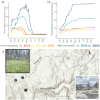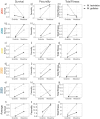This is a preprint.
Short-term fluctuating and long-term divergent selection on sympatric Monkeyflowers: insights from decade-spanning reciprocal transplants
- PMID: 38979251
- PMCID: PMC11230446
- DOI: 10.1101/2024.06.26.600870
Short-term fluctuating and long-term divergent selection on sympatric Monkeyflowers: insights from decade-spanning reciprocal transplants
Abstract
Sympatric species are often locally adapted to distinct microhabitats. However, temporal variation may cause local maladaptation and species boundary breakdown, especially during extreme climatic events leading to episodic selection. Repeated reciprocal transplants can reveal the interplay between short and long-term patterns of natural selection. To examine evolutionary trajectories of sympatric Monkeyflowers adapted to different niches, Mimulus guttatus and M. laciniatus, we performed three replicated transplants and combined them with previous experiments to leverage a dataset of five transplants spanning 10 years. We performed phenotypic selection analyses on parents and hybrids in parental habitats in Yosemite NP, CA during years of drastically differing snowpack. If there is ecological isolation, then we predicted divergent phenotypic selection between habitats in line with species' differences and local adaptation. We found interannual fluctuations in phenotypic selection, often in unpredicted directions. However, a combined-year analysis detected longer-term divergent selection on flowering time, a key temporally isolating and adaptative trait, suggesting that selection may reinforce species boundaries despite short-term fluctuations. Finally, we found temporal variation in local adaptation with M. laciniatus locally adapted in low snowpack years, while an extremely high snowpack year contributed to average local maladaptation of M. guttatus.
Keywords: adaptation; divergence; environmental variation; evolution; natural selection; phenology; speciation; temporal variation.
Conflict of interest statement
COMPETING INTERESTS None declared.
Figures





References
-
- Aarseen LW, Taylor DR. 1992. Fecundity allocation in herbaceous plants. Oikos 65: 225–232.
-
- Aarssen LW, Jordan CY. 2001. Between-species patterns of covariation in plant size, seed size, and fecundity in monocarpic herbs. Ecoscience 8: 471–477.
-
- Anderson JT. 2016. Plant fitness in a rapidly changing world. New Phytologist 210: 81–87. - PubMed
-
- Anderson JT, Eckhart VM, Geber MA. 2015. Experimental studies of adaptation in Clarkia xantiana: III: Phenotypic selection across a subspecies border. Evolution 69: 2249–2261. - PubMed
-
- Anderson JT, Wadgymar SM. 2020. Climate change disrupts local adaptation and favours upslope migration. Ecology Letters 23: 181–192. - PubMed
Publication types
Grants and funding
LinkOut - more resources
Full Text Sources
Miscellaneous
